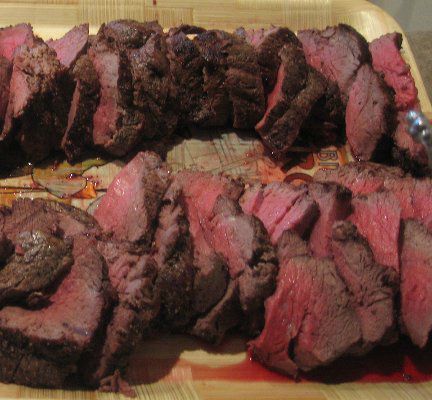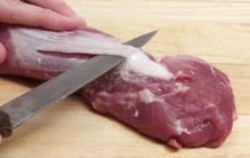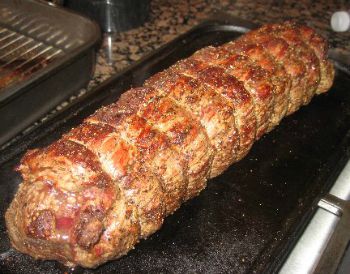This is a very special tenderloin beef roast that is sure to please the red meat and Pinot Noir crowd. The cracked pepper coating brings a hot spice flavor to the meat. I also suggest your served this Peppery Pinot Noir Tenderloin Roast with an Oregon Pinot Noir wine.

Check out all of Linda’s Beef Recipes using various cuts of beef.
Please check out my Grilled Peppery Pinot Noir Tenderloin dinner menu which is built around this dish.
- 3 tablespoons butter, room temperature, divided
- 1 tablespoon flour
- 1 cup onion, finely chopped
- 1 cup carrot, finely chopped
- 1 cup celery, finely chopped
- 2 tablespoons tomato paste
- 1 1/4 cups Pinot Noir Wine
- 1 1/4 cups chicken stock or broth (low-salt)
- 1 1/4 cups beef stock or broth
- 2 tablespoons heavy cream
- Salt and pepper to taste
- 1 (3 to 4-pound) beef tenderloin roast
- 4 to 6 tablespoons black pepper, coarsely-ground
-
Making Pinot Noir Wine Sauce:
-
In a small bowl, mix together 2 tablespoons butter and flour; set aside.
-
In a large frying pan over low heat, melt remaining 1 tablespoon butter. Add onion, carrot, and celery; saute approximately 10 minutes or until vegetables are tender. Add tomato paste and stir until vegetables are coated. Add wine and boil approximately 3 minutes or until liquid is reduced by half. Add chicken and beef broths; boil approximately 5 minutes or until liquid is reduced to 1 1/4 cups.
-
Remove from heat and strain liquid, discarding solids. Return liquid to pan; add reserved butter/flour mixture and whisk over medium heat about 1 minute or until sauce thickens. Add heavy cream at the very end (do not overheat the cream). Season to taste with salt and pepper.
-
Sauce can be prepared 1 day ahead. Cover and refrigerate.
-
Trimming the tenderloin roast:
-
Bring the tenderloin roast to room temperature before cooking.
-
Trim the tenderloin of fat and silverskin. Silverskin is a silvery-white connective tissue. It does not dissolve when the tenderloin is cooked, so it needs to be trimmed away. If the silverskin is not trimmed off, it will cause the tenderloin to curl up into the shape of a quarter moon. If you ask, your butcher will do this for you.

-
Trussing the tenderloin roast:
-
Once the tenderloin roast is trimmed, it no longer has any structure and will start to flatten out. As you want the meat as round as possible for even cooking and also for presentation, trussing is the key.
-
Using individual pieces of kitchen twine/string to truss the roast. Tie the kitchen string around the tenderloin roast with equal spacing between each truss. Tie the meat firmly, but not too tight. NOTE: I usually have my butcher do this for me.

-
Pat the beef dry with paper towels (this is important as surface moisture will interfere with good browning). Lightly oil outside of the roast.
-
Searing the tenderloin roast:
-
Pat the beef dry with paper towels (this is important as surface moisture will interfere with good browning). Lightly oil outside of the roast and sprinkle with coarse salt; pat ground peppercorns all over the meat, pressing into the meat with the palm of your hand.
-
By browning the meat's proteins and sugars, you are enhancing the meat's flavor even more.
-
Heat a large cast-iron griddle over high heat. Without adding any cooking fat, sear the roast on all sides (about 3 rotations, approximately 1 minutes each). NOTE: Resist the temptation to constantly turn the beef from side to side and you will be rewarded with a beautifully browned crust. When browned, immediately remove from heat.

-
Roasting the tenderloin roast:
-
Preheat oven to 450 degrees F. Tenderloin, like other lean cuts of meat, are best roasted at a high heat rather than baked at lower temperatures. Flavor comes from the browning, not from fat slowly melting into the meat.
-
Place the seared roast in a large baking pan or roasting pan and bake, uncovered. Roast in oven approximately 20 to 40 minutes (depending on size of your roast) until a meat thermometer registers desired internal temperature. NOTE: Turn tenderloin over halfway through cooking for even browning.
-
What constitutes rare and medium-rare cooked meat? To satisfy government home economists, the Beef Council says rare beef means an internal temperature of 140 degrees F. Well, that is ok if you like well-done and dry meat. If you like moist, rosy meat (like I do), rare begins when the internal temperature registers 120 degrees F. and starts to become medium rare at 125 or 130 degrees F. To cook your meat properly, you must purchase and use a good instant-read digital meat thermometer.
-
When the tenderloin roast is cooked to your liking, remove from oven, and transfer onto a cutting board; cover with a tent of aluminum foil and let stand 15 minutes before carving (meat temperature will rise 5 to 10 degrees after it is removed from the oven).
-
When ready to serve:
-
In the same Cast Iron Frying Pan over medium heat, re-warm Pinot Noir Sauce over low heat; mix in any juices from roast.
-
Cut the roast into 1/2-inch slices and place them on a warm serving platter. To serve, spoon some Pinot Noir Sauce over the meat; pass remaining sauce separately. Serve immediately.
-
Makes 6 to 8 servings.
 I get many readers asking what cooking/meat thermometer that I prefer and use in my cooking and baking. I, personally, use the Thermapen Thermometer. Originally designed for professional use, the Super-Fast Thermapen Thermometer is used by chefs all over the world. I only endorse a few products, on my web site, that I like and use regularly.
I get many readers asking what cooking/meat thermometer that I prefer and use in my cooking and baking. I, personally, use the Thermapen Thermometer. Originally designed for professional use, the Super-Fast Thermapen Thermometer is used by chefs all over the world. I only endorse a few products, on my web site, that I like and use regularly.
You can learn more or buy yours at: Super-Fast Thermapen Thermometer.
Sponsored Content
Favorite Beef Tenderloin Roast Recipes:
Peppery Pinot Noir Tenderloin
Peppered Lavender Beef
Peppered Chutney Tenderloin
Pepper-Wine Beef Tenderloin
Beef Tenderloin Roast – Filet of Beef Roast



